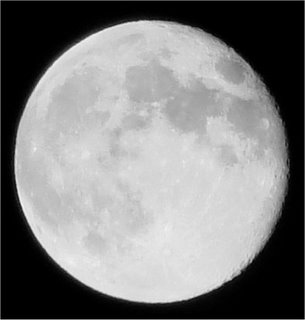I bought a Sony Cyber-shot H5 camera. It looks like no camera I've ever seen but it's capable of exposures up to 30 seconds and gives me almost as much control over the photos as any of my film cameras. It also accepts filter holders so I won't have to hold that infrared filter over the lens by hand.
I had my doubts whether any digital was up to the job, but it can do this:

I've tried to get a good moon photo for years. Even with two tripods, one under the lens and one under the camera, I still had shake because of the motion of the shutter. A digital has no shutter movement.
Okay, I can't enlarge this because it pixellates, but it's not bad. Film could show finer detail but the shutter movement always caused shake.
Now I have to try it with infrared. It occurred to me while playing with this camera that the reason video cameras never do well with non-illuminated IR at night is down to shutter speed. You can't slow a video camera's shutter speed too much or the video becomes jerky. The filter is a 3mm thick block of opaque plastic so a slow shutter speed is essential.
I'll see what the H5 can do with long exposures through that filter at night.
So I'm a partial convert to digital cameras. I'm still taking my film cameras with me, and orbs are still bunk.
On some subjects, I'm unshakeable.
2 comments:
Somewhere, there's a good explanation with diagrams. I'll try to find it because it'll save me trying to redraw them.
In the meantime. orbs aren't 'faults in the camera' as some sites claim. They are external to the camera optics. Faults in the detector show as blue, red, green or white dots where a pixel has gone bonkers.
Catching an 'orb' is a matter of illumination. You can get them on film cameras too, mainly on those cameras which (like digital cameras) have the flash close to the axis of the lens. On those night-shot video cameras, the IR illumination is similarly placed.
Taking photos in natural light, without flash, rarely illuminates the dust floating around. Using a flash, and assuming that there's dust in the right place, the flash hits the dust which causes a bright spot right in front of the lens. It's too close to focus so it's blurred. The IR light close to the lens does the same job. If there doesn't happen to be a bit of dust in front of the (often small) lens at the right time, then you don't get an orb.
It's better explained with diagrams. I'll hunt down that site.
I've read a few tonight which insist orbs are real, and that any attempt to deny them is the desperate grasping-at-straws of the sceptic.
Well, I know ghosts are real. I don't believe orbs are. They certainly will never convince anyone so it's pointless to collect photos of them.
If you can see an unexplainable light with the naked eye, then it's worth investigating. If you can't see it without a camera, then it's dust.
The trouble with all these orb images is that if someone photographs a real ghost-light, it's just going to be lumped in with the dust-photos by the sceptics. That makes images of real ghost lights all but impossible to find.
The moon shot: The trick is in the camera's light meter. It can be set to meter light only from a point in the centre of the screen, rather than all over the sky. That gave me a 1/10-second exposure at F2.8 (the camera can auto-set the ASA rating it uses). It wasn't so much the moon's motion that night, it was the clouds zooming across in front of it!
I have a lot of photos on 35mm film, taken with a 2m focal length lens. Exposure times were 1 second or less. The problem was stopping any motion when taking the shot. So those photos are properly exposed but very badly shaken!
I'm having a great time reading through your archives today. Cliches that come to mind - caustic wit, razor sharp tongue, high intelligence. Wish I didn't have to stop to get some work done, but I do. I'm leaving this bookmark here for myself, so I'll know where to pick up: Begin with February 2006.
Post a Comment